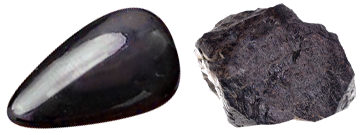 Photo of Hematite in Processed & Rough Form
Photo of Hematite in Processed & Rough Form
Hematite is a mineral with a hardness of 7 out of 10 on the Mohs scale of mineral hardness [?]. These Trigonally structured gems are made of iron oxide, their full chemical compound being Fe2O3.
Hematite is considered the most important Iron Ore mineral. Its crystals appear as reasonably thick. They may be tabular, or rhombohedral, and occasionally prismatic or pyramidal. Tabular crystals may form as rosettes, when they are called "iron roses."
It also occurs as massive, compact, columnar, fibrous, reniform, botryoidal, stalactitic, foliated, and granular. When hematite forms in a reniform habit, it is known as kidney ore.
It is dark, blackish gray, non-transparent and with a metallic luster. This luster and color are highly characteristic, and still more so is the red streak it leaves if drawn across a piece of unglazed porcelain. It dissolves slowly when heated in concenttrated hydrochloric acid, and is infusible. It becomes magnetic if heated in reducing flame.
Its color ranges from brownish, bright red, blood-red, and brownish-red, to steel-grey, and iron black. When appropriately lit, crystals appear a lustrous black, sometimes with iridescent tarnish.
It occurs as a hydrothermal and replacement mineral, and also forms in igneous rocks as an accessory mineral. Individual deposits may be intramagnetic, sedimentary, metamorphic. It forms under oxidizing conditions, as compared to magnetite. Much hematite is formed under sedimentary conditions through diagenesis of limonite, retaining its concretionary and oolitic forms. It remains stable in a low-temperature metamorphic environment where it often replaces magnetite. It also occurs as a sublimation product of volcanic exhalations.
Cumbria (England) has produced notable specimens and exceptional crystals and iron roses have been described from Val Tavetsch, Grisons, (Switzerland), and from locations in Minas Gerais (Brazil) where they sometimes reach 6 inches in diameter; those at Mesa Redonda and Congonhas do Campo are notable. The samples from Great Britain, Switzerland, Germany, and the island of Elba are suitable for ornamental purposes. There are oolitic deposits in Tennessee (USA), the Ukraine, and Canada.
The largest deposits are at Lake Superior (USA) and in Quebec (Canada), Venezuela, Brazil, and Angola.
Hematite (mineral) is not normally attracted by an iron magnet though artificial forms of similar composition do respond. The material hemetine is one example. A material reported to be from Zimbabwe and gives a notably intense almandine spectrum; it shows a deep red on passage of a strong ray of light.
Oolites, itabirites, and micaceous hematite are "ferrolites." Hematite is sometimes confused with cassiterite.
What causes Hematite's metallic to submetallic luster?
The metallic luster results from high optical absorption coefficients and electronic structure. Crystal size and orientation affect reflectivity, with specular hematite showing mirror-like surfaces.
How does crystal structure influence magnetic properties?
Hematite exhibits antiferromagnetic ordering below 948K. The corundum-type structure with iron ions arranged in a distorted octahedral coordination influences its weak ferromagnetic behavior.
What distinguishes microplaty from specular Hematite?
Microplaty hematite consists of microscopic crystalline plates, while specular hematite forms larger crystalline plates. This morphological difference affects physical properties including luster, streak, and apparent hardness.
How do formation conditions affect crystal habit?
Temperature, pressure, and oxygen availability during formation determine crystal habit. Hydrothermal conditions typically produce tabular crystals, while metamorphic environments may yield micaceous formations.
What causes iridescence in Rainbow Hematite?
Iridescence results from thin-film interference on tarnished surfaces or between microscopic crystal layers. The phenomenon requires specific structural spacing and orientation of crystalline plates.
How is density variation explained crystallographically?
Density variations (5.26-5.32 g/cm3) correspond to subtle differences in crystal packing and trace element incorporation. Structural defects and inclusions can further modify observed density values.
What analytical methods confirm Hematite identification?
X-ray diffraction confirms crystal structure, while spectroscopy characterizes iron oxidation state. Magnetic susceptibility measurements and optical properties provide additional diagnostic criteria.
The specific gravity [?] for Hematite is 5.2, its refractive index [?] is 2.94-3.22, and its double refraction [?] is 0.28.
History
The name hematite comes from the Greek root "alma" or "ema" meaning "blood," because of the red color of the powdered hematite and the color of some larger examples. When cut, the coolant is colored red. Shiny hematite crystals are sometimes called "specularite" Latin for "mirror," as they were used as a mirror in ancient times. It was also used as an amulet against bleeding, acting in a similar way to alum, which is used in styptic pencils. It was also used as mourning jewelry.
Industrial Usages
Hematite mineral is the most important iron ore, and is in all the various uses of iron. When earthy and mixed with clay minerals, it forms red ochre, which is used as a pigment and a polishing powder (jeweller's rouge). It is the most oxidized form of iron oxide and is a major constituent of rust.
Compact, concretionary masses of hematite crystal are suitable for cutting into gems and today has a resurgence in popularity. It is faceted, cut into cabochons, or engraved. It lends itself well to the manufacture of signet rings. Other pieces are fashioned into necklaces or pendants.
When cut into thin plates, hematite is red and transparent; when polished, it is very shiny. It has been imitated by pressing and sintering hematite splinters.









